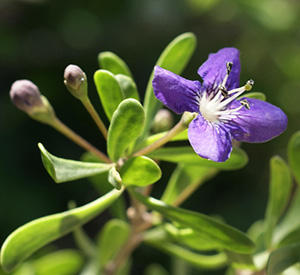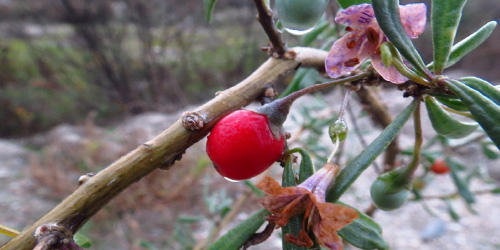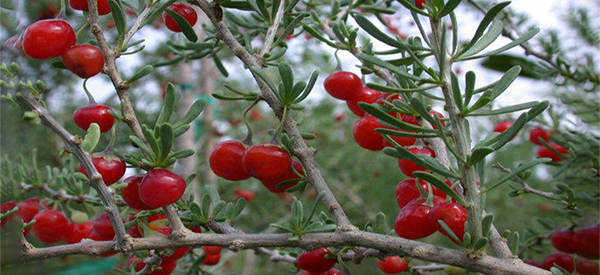I have problems with inflammation, so I am always looking to eat anti-inflammatory superfoods. In recent years, the Goji berry has emerged as a superfood with high concentrations of anti-oxidants. It is reported to have anti-aging, anti-cancer and anti-disease properties, and a host of other benefits for the body’s systems.
These benefits come at a high price, though – $12/lb or more. But there is a relative of the Goji berry that you can harvest from the wild—or plant in your garden. The Christmas berry, Lycium carolinianum, also called Carolina wolfberry is the plant that I am familiar with and writing about here. There are about 70 to 80 varieties of Lycium, many of them found in the United States. Some, but not all, have medicinal value. Research the varieties found near you to make sure they are edible and medicinal.
Identify Christmas Berries
 The Christmas berry is a perennial member of the nightshade family, Solanaceae. The plants are thorny evergreen shrubs that grow to three to twelve feet tall, with a spread of three to six feet.
The Christmas berry is a perennial member of the nightshade family, Solanaceae. The plants are thorny evergreen shrubs that grow to three to twelve feet tall, with a spread of three to six feet.
The small, narrow leaves are arranged alternately. Fleshy, succulent leaves are elongated and rounded on the tip. The branches and plump leaves resemble rosemary stems, except that the leaves are flattened and rounded on the tip.
Each plant has several woody stems which sprout flowers and support the berries. Flowers are funnel-shaped and single or arranged in small clusters, blue or mauve in color and attract butterflies.
The flowers have both male and female parts and are pollinated by bees. It should be noted that Lycium carolinianum flowers have four petals, while other members of the Lycium family have five.
Christmas berries are up to a half inch in diameter. The fruit normally ripen from October through April and are a food source for local birds. In some areas, the red berries can be found year round.
Where to Find Christmas Berries
In my area Christmas berry grows along the coast, but it is also found in salt marshes, sand dunes, and coastal areas throughout the Southeast. It grows well in zones 7 to 10, but it is reported hardy to zone 5.
The plants are salt tolerant and can withstand strong winds. If you want to grow them, you can usually find the plants potted in native plant nurseries.
Edible Use of Christmas Berries
The ripe fruit are edible, either raw or cooked. The taste is sweet, sour, and slightly salty. Only fully ripe fruit should be eaten; avoid any fruit that is not completely red in color. Other parts of the plant are not edible. Related: 10 Edible Roots That Kept This Hermit Monk Alive
Related: 10 Edible Roots That Kept This Hermit Monk Alive
Medicinal Use of Christmas Berries
Like its cousin, the Goji berry, the berries are an excellent source of anti-oxidants and numerous vitamins and minerals, including vitamins A, C, E, flavonoids, and essential fatty acids.
The berries are currently being researched for their role in preventing and treating cancers. Early evidence shows they can prevent some cancers, including skin cancers, and reverse the disease in some cases.
Lycium carolinianum is only just beginning to be studied for its health benefits, but our grandmothers used it regularly as an anti-aging tonic and a treatment for many of the diseases of aging, including ischemic stroke, nerve inflammation, and age-related eye problems.
It is also believed to be helpful in treating diabetes and many of the problems associated with diabetes such as high blood sugar, high blood pressure and preventing retinal decline.
The berries boost the immune system and protect the liver, helping the body heal from any disease process. It helps build the blood in people with anemia and fatigue.
Skin irritations, burns, and wounds also benefit from eating the berries, drinking the juice, or washing with the tea.
Other Reported Uses For Christmas Berries:
- Controls cholesterol levels
- Protects the heart
- Improves gastrointestinal function
- Reduces stress and fatigue
- Protects the liver
- Improves sleep
- Protects the eyes from degenerative diseases
- Protects from the flu
- Improves erectile dysfunction
- Helps mental focus
Eating Lycium Carolinianum
Christmas berries can be eaten whole either raw or cooked, dried for later use and powdered, or juiced. Tea can also be made from the dried berries and drunk hot or cold, or used as a topical wash for the skin.
A small handful of Christmas berries daily is enough to gain medicinal benefits. I add a couple of ounces of the dried berries to my morning smoothie.
They must be harvested by hand and processed within 24 to 48 hours to preserve their nutritional and medicinal value. Only harvest berries that are fully ripe and show no signs of being over-ripe. The berries spoil quickly, so pick only as many as you can use at a time. They will keep better on the plant.
Is Lycium Carolinianum Safe?
Do not use Lycium carolinianum if you are pregnant or breastfeeding – there is no research indicating their safety for pregnant women or their babies. Additionally, miscarriages have been reported.
There are no known toxic effects of Christmas berries, but it is important to note that it is a member of the nightshade family. There are many toxic members of the nightshades, so it makes sense to be sure of your plant identification and start use slowly. Some people are allergic to nightshades and can have adverse reactions.
You may also like:
16 Superfoods for Blood Circulation
Arizona Farmer Accidently Discovers Trick to Turn Air into Water (Video)
The Only Plant That Should Be in Your First Aid Kit















Hello- WOW! So I can grow this “Christmas berries” plant in Los Angeles California? Do they grow wild here? Can you put me in touch with local grower?
Go to Hudson seedsman and look for a California native. There’s got to be a half-dozen varieties of wolfberry in the Southwest. niio
I’m looking for wolfberries native to Arizona. Ha. Everyone wants to sell Goji for an arm and a leg. Throw in a pit of blood, so you can get one. Wolfberries are native, and have the same properties as Goji. Chinese miners and railroad workers saw no difference, but PC salesmen sure do.
I think your article just contradicted itself. Nighshades give you inflamation, they do not take it away. I say this because I’m always reading about them being removed from my diet so that I don’t have any pains caused by nightshades.
It is true that allergic and inflammatory reactions to nightshades are not uncommon. If I eat too many peppers I get symptoms of Rheumatoid arthritis, but it is also true that peppers are an incredibly nutritious food with lots of medicinal uses, and I eat Habanero almost daily, it hurts so good…
Taters are another big problem, taters are a delicious gift from the Pagan Gods, but taters makes me fat and gives me gas. I am a better person when I don’t eat taters, sigh…
Tomatoes! Delicious symptom free night shade! Why are you so hard to grow?
Eggplant, meh…
Tobacco, what can I say?
Jimson weed, I grow it for hawk and hummingbird moths, Don Juan Matus knows how to prepare it as a psychedelic but I don’t…
Belladonna, if Saddam had really had the Yellow Rain our guys would have used Atropine to save the lives of those poisoned…
Silver leaf nightshade might be the most useful, it has an incredible history of medicinal use in the Southwest U.S., you can even use it to turn milk into cheese!
And let’s not forget the pickers on silverleaf stems 🙂 Or that it spreads… Eggplant parm is great. Do you grow chilitepin chilis? niio